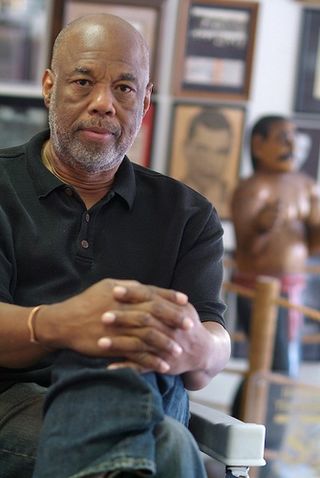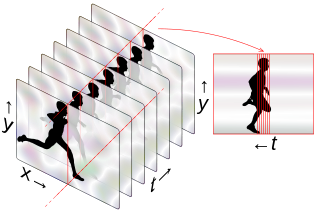
Alfred Eisenstaedt was a German-born American photographer and photojournalist. He began his career in Germany prior to World War II but achieved prominence as a staff photographer for Life magazine after moving to the U.S. Life featured more than 90 of his pictures on its covers, and more than 2,500 of his photo stories were published.
Walter Iooss Jr. is an American photographer noted for his images of athletes, including Michael Jordan, Kelly Slater, Tiger Woods, Scottie Pippen, and Muhammad Ali. He has been called "the poet laureate of sports."
Hyman Peskin was an American photographer known for several famous photographs of American sports people and celebrities published by Sports Illustrated and Life. He was a pioneer of sports photography, with his work being ranked amongst the best sports photojournalism of the 20th century. In 1966 he changed his name to Brian Blaine Reynolds, and founded the Academy of Achievement, bringing young people together with statesmen and Nobel Prize winners.

David Hume Kennerly is an American photographer. He won the 1972 Pulitzer Prize for Feature Photography for his portfolio of photographs of the Vietnam War, Cambodia, East Pakistani refugees near Calcutta, and the Ali-Frazier fight in Madison Square Garden. He has photographed every American president since Lyndon B Johnson. He is the first presidential scholar at the University of Arizona.

Howard Leonid Bingham was a biographer of Muhammad Ali and a professional photographer.

Sports photography refers to the genre of photography that covers all types of sports.
Herbert "Herb" Scharfman was an American sports photographer notable for several famous photographs of American sports people published by Sports Illustrated and other publications.

Kevin P. Coughlin is a photojournalist, writer, governmental photographer, pilot, and aerial cinematographer. He is the former executive photographer to New York Governors Kathy Hochul and Andrew M. Cuomo. His photographs at Ground Zero following the September 11, 2001 attacks on the World Trade Center and while covering funerals and memorial services of fallen fire fighters, police officers, and emergency personnel killed as a result of the attacks are included in the 2002 Pulitzer Prize awarded to The New York Times for Public Service. In addition to The New York Times, his photographs have appeared in the New York Post, New York Daily News, Newsday, The Philadelphia Inquirer, The Los Angeles Times, Bloomberg News, Business Week, People, Sports Illustrated, Rolling Stone, Time, USA Today and The Wall Street Journal. He has also written magazine articles for GQ and News Photographer.

This article covers the boxer Muhammad Ali's appearances in media and popular culture.
George Kalinsky is a photographer. He has been the official photographer for Madison Square Garden since 1966 and also serves as the official photographer at Radio City Music Hall. In November 2010 the National Arts Club awarded him their Medal of Honor for Photography.

Robert Riger was an American sports illustrator, photographer, award-winning television director, and cinematographer. John Szarkowski, former director of the photography department at the Museum of Modern Art, said, "His photographs are documents, and the best of them are also pictures that now have a life of their own, and that would have given intense pleasure to George Stubbs and Winslow Homer and Thomas Eakins." David Halberstam, said "Robert Riger was the preeminent artist of a golden age of American sports in the years after World War II."
Rich Clarkson is a Denver, Colorado based photographer that has a long history covering American sports. Rich owns a production company, Clarkson Creative, that specializes in photography, video production, design, and book publishing among other things. In addition, his company has organized the top-tier photography educational workshops, Summit Series of Photography Workshops, for over 30 years. The small group also handles all championship photography for the NCAA and Colorado Rockies baseball club.

John Gerald Zimmerman was an American photographer. He was among the first sports photographers to use remote controlled cameras for unique camera placements, and was "a pioneer in the use of motor-driven camera sequences, slit cameras and double-shutter designs to show athletes in motion."

Strip photography, or slit photography, is a photographic technique of capturing a two-dimensional image as a sequence of one-dimensional images over time, in contrast to a normal photo which is a single two-dimensional image at one point in time. A moving scene is recorded, over a period of time, using a camera that observes a narrow strip rather than the full field. If the subject is moving through this observed strip at constant speed, they will appear in the finished photo as a visible object. Stationary objects, like the background, will be the same the whole way across the photo and appear as stripes along the time axis; see examples on this page.

Steve Schapiro was an American photographer. He is known for his photojournalism work and for having captured key moments of the civil rights movement such as the March on Washington for Jobs and Freedom and the Selma to Montgomery marches. He is also known for his portraits of celebrities and movie stills, most importantly from The Godfather (1972) and Taxi Driver (1976).
Jerry Cooke was an American photojournalist from the 1940s-1990s.
Keepers of the Streak is a documentary by ESPN Films that focuses on four photographers who have attended and photographed the first forty-eight Super Bowl games from 1967 to 2014. John Biever, Walter Iooss, Mickey Palmer and Tony Tomsic are the focus of the film, and have their stories told throughout. It is directed by Neil Leifer.

Bob Gomel is an American photojournalist who created images of 1960s world leaders, athletes, entertainers, and major events. His photographs have appeared on the covers of Life, Sports Illustrated, Newsweek, Fortune, and Forbes, and in Time, The New York Times, and Stern, and in more than 40 books. Gomel's images are held in the collections of the U.S. Library of Congress and the Museum of Fine Arts in Houston.

Rob Shanahan is an American photographer and rock drummer known for his concert photography and portraits of celebrities. He has been the preferred photographer of ex-Beatles drummer Ringo Starr since 2006.
Fred Lyon was an American photographer. He was known for shots of foggy San Francisco, and photos of San Francisco life from the 1940s to the 1960s. Lyon worked in different roles within photography, including as a military photographer, a photojournalist, a fashion photographer, landscape photographer, and as a street photographer. His nocturnal San Francisco photography was often compared with Hungarian–French photographer Brassaï.












